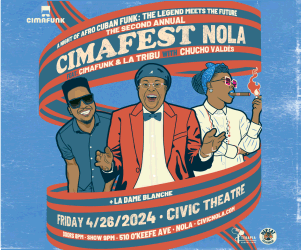“[The title for Funk Yard] actually started with a picture. I was working with Bob Compton, who’s a photographer, and we were looking for a name for the record and thinking about different album covers. He had this picture of this thing, a funk yard, apparently a junk yard someone homemade with the [cover image] tire, all that. It was great and it just stuck with me.
Back in that day, I was still playing with ‘Gatemouth’ Brown. We were still touring, going to Europe a lot and playing all the festivals around the country. I was making my own records and had my own band on the side and playing solo gigs. Gatemouth never had that 250-dates-a-year thing—it was more 100, 125 dates a year—so I pursued my own stuff. We played the Funky Butt every other Thursday night, one Sunday a month at the Maple Leaf, once in a while over at Le Bon Temps. Sometimes we’d hit at House of Blues or Tip’s. Just doing the local music scene.
Funk Yard was my fifth CD without Gatemouth. I did a solo piano album called Just the Piano… Just the Blues. Then we did my first organ one, Down & Dirty. Then after that Buckle Up, an organ one, then I did New Orleans Piano Rolls, which was another piano CD. Then I did Funk Yard. That was five CDs in six years. They were all on a local label, STR Records, which was run by a couple of professors at Loyola [University]. The main guy was Sandy Hinderlie, who ran the recording studio at Loyola. He had a recording class and he needed bands to record so his students could experience that. It was a symbiotic relationship. Sometimes we had student engineers, sometimes they were just assisting, but they were getting the whole recording experience and we were getting records out of it.
We did all these records up at Loyola. Funk Yard was interesting because I used a different organ. I had this [Hammond] A-100 that I was carrying around and wanted to record with it. All my other organ records I did with this 1958 B-3—that’s my number-one organ. I didn’t write all the material on Funk Yard—I wrote five or six songs. The other guys in the band contributed, too, and it was a nice experience to have everyone chipping in some music.
I had [guitarist] John Fohl, who around that same time went on to play in Dr. John’s band. I had Mike Barras on the drums and Brent Rose on saxophone. I used two different bass players: mostly Jim Markway, and the other was Bob Sunda, who after Katrina moved up to Memphis.
When you’re playing live, you’re in the moment and you’re stretching. Sometimes you’re hitting your mark and sometimes you’re not quite hitting it. [laughs] Things don’t all fall together at the right time or in the right space. Being in the studio is a different piece of artwork. You’re trying to create a performance that’s as perfected as you can make it. You have things climaxing all together; you have the execution all very precise. Sometimes it’s contrived sounding, all planned out, and I feel it can sometimes miss that spark when you hit something and it falls into place and becomes very intense.
In the studio, you can really craft the finished product better. When you’re playing live, there’s a big spontaneous burst that happens and you hope it comes out as this big beautiful picture. Whereas when you’re in the studio, you do it and then you stand back and wonder, ‘How can I adjust this? How do I make that burst more accurate?’”




